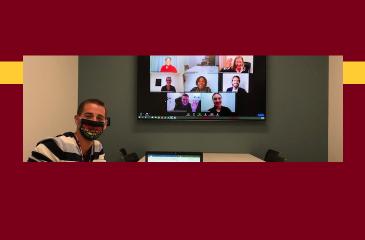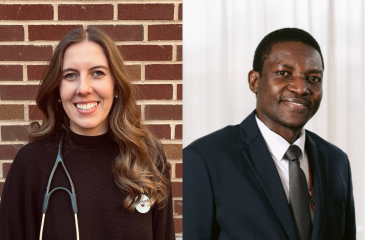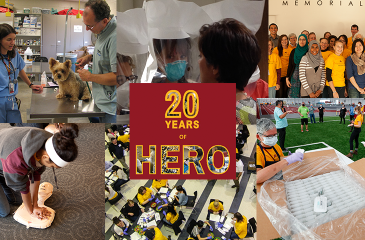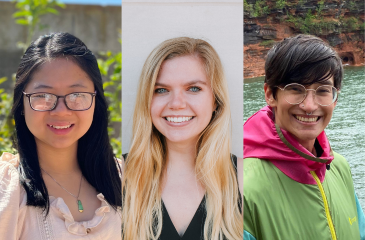In 2020 so far, M Simulation has held 22 days of interprofessional education events, reaching 434 learners from nursing, pharmacy, social work, dentistry, the Medical School, and beyond. M Simulation works closely with faculty to design and deliver simulated training experiences for health sciences learners at the University and for external stakeholders of wide-ranging professions in Minnesota and nationwide.
For a year that has transformed health care as we know it, the M Simulation team is committed to the continuity of health care education and ensuring the safety of providers, learners, and patients.
“Our mission as a team is to use our expertise as simulation professionals to collaboratively design educational scenarios, train standardized patients, implement scenarios, and help assess curriculum,” said Executive Director Lou Clark, PhD, MFA. “This year we had to pivot online like many others. We have not turned away anyone during the pandemic who wants to adapt their curriculum with us. We will work with stakeholders on any simulation needs.”
Making Lemonade
The team of simulation educators have been working across the health sciences since 2003. They have built partnerships with faculty in different disciplines and professions and can help build bridges for colleagues who are interested in doing interprofessional activities.
“The simulation community is a very close knit one. We can reach out across the country and try to make connections for people,” said Clark. “Facilitating collaboration online has really opened new doors for us. We’re making lemonade out of lemons.”
“Historically, bringing together different groups of learners on-site at the same time has been one of the biggest challenges,” said Anne Woll, MS, education director for M Simulation. “We've reduced that barrier through online human simulation. I think that's a real advantage going forward, even post-pandemic, to promote interprofessional education.”
With the recent move to the Health Sciences Education Center, M Simulation is more dedicated than ever to expanding training events. In addition to their work with human simulation online, some members of the team have been working on-site in the pandemic to support technical and procedural skills training for learners since June 2020.
You can check out a chapter detailing human simulation online co-authored by the M Simulation Team recently published in a new book co-edited by Clark: Comprehensive Healthcare Simulation: Implementing Best Practices in Standardized Patient Methodology.
Interprofessional Education
In mid-October, the team implemented a large scale online event with social work and nursing, exploring models of interprofessional care. They partnered with students in Minnetonka’s VANTAGE program, who helped portray teens struggling with mental health and substance abuse issues. They ran two different scenarios in which learners worked with patients separately and then together as an integrated care team.
“The complexity of the case scenarios reminds us that patients don't come to us with just one problem,” said Woll. “As those needs are made visible to a provider, it becomes clear that an interprofessional team approach can help address those needs.”
This partnership goes back to 2015, as part of nursing curriculum and extended training opportunities for social work. M Simulation worked with nursing and social work faculty to co-develop the case scenarios and facilitate standardized patient training, as well as learner debriefing. This year, they adapted programming online to replicate features of telehealth.
“There's a primary care shortage of physicians in our country, and so much of that care is now coming from our allied health professions. Oftentimes, it's social workers and family nurse practitioners who are doing frontline visits and counseling as a part of their jobs. It's more important than ever that these specialists are on the same page,” said Clark. “This event gives our students the opportunity to practice working together.”
2020 in Review
There have been many notable projects over the past year, and of those, the M Simulation team is especially proud of their work with the School of Nursing, the OB/GYN residency, and the Family Tree Clinic. Together, they partnered with community members who identify as transgender or non-conforming to work as patient teachers and case authors in order to better serve this population.
“We know that training in this area is limited and the comfortability of learners is varied. By engaging patient teachers who belong to specific populations, we were able to move forward with the goal of creating an authentic, medically sound scenario that felt not only psychologically safe for the patient teachers but representative and reflective of the patients that our learners would be encountering in clinical practice,” said Joseph M. Miller, BS, CHSE, M Simulation’s human simulation program manager.
“As we think about populations who have been traumatized in health care or marginalized in the delivery of health care, partnering with communities has the reciprocal benefit of building trust and helping the entire team move forward with the patient at the center,” said Woll.
The team is exploring ways to adapt programming to telehealth to ensure training continues.
“It's key to get stakeholders at the table and to make sure their voices are heard and included,” said Clark. “It is part of our best practices as simulation experts to include people with lived experience in education and training.”



